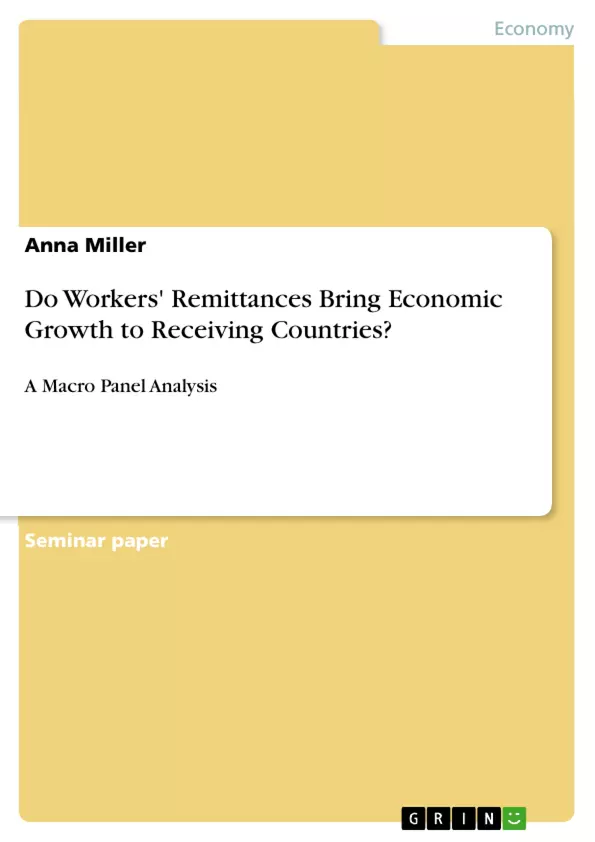Besides foreign direct investment (FDI) and capital market flows, workers’ remittances are another external channel for capital flows. According to the OECD, remittances to developing countries amounted to US$ 149.4 billion in the year 2002. However, whereas FDI and capital market flows are subject to variation due to recessions in home countries, remittances are steadily rising every year (OECD, 2006), reaching an amount of about UD$ 300 billion in the year 2007 (Barajas et al., 2009). To give a brief definition, remittances are money transfers from migrants working abroad to their families in their home countries. Yet, the question is, do these remittances contribute to or boost economic growth in receiving countries or are they only a means to increase the migrants’ families’ welfare by directly reducing their poverty and raising the living standard (Rao and Hassan, 2011). In other words, are remittances mostly used for consumption or do they rather flow in education, and thereby contribute to the human capital, and in investments, thus increasing the capital stock in the economy (Giuliano and Ruiz-Arranz, 2009)? From the growth theory we know that consumption does not have any impact on growth, only investments, either in production or in human capital, can affect long-run growth. Evidence from Indonesia, Ecuador, and Argentina (Sayan, 2006) shows that remittances indirectly reduce volatility of growth of output in times of crises and increase the growth rate thereby (Rao and Hassan, 2011). In contrast, Sayan (2006) found that remittances are moving procyclically with out in recipient countries, boosting incomes during booms, but reducing them even more during recessions and thus magnifying the economic crisis. This paper examines the relationship between remittances and GDP growth using in a macro panel with 67 countries and a time period of 28 years, from 1975 through 2002, as well as a cross-section analysis for comparison. The goal of this analysis is to determine whether, and to what extent, remittances have an impact on long-term economic growth and, if so, whether this relation is significant or not.
Inhaltsverzeichnis (Table of Contents)
- Introduction
- Idea of the Growth Theory
- Data
- Model and Empirical Analysis
- Results
Zielsetzung und Themenschwerpunkte (Objectives and Key Themes)
This paper aims to investigate the relationship between workers' remittances and GDP growth in developing countries. It seeks to determine whether remittances have a significant impact on long-term economic growth and, if so, to what extent. The analysis is based on a macro panel dataset encompassing 67 developing countries over a period of 28 years, from 1975 to 2002.
- The impact of remittances on long-term economic growth in developing countries
- The role of remittances in addressing poverty and improving living standards
- The relationship between remittances and investment in human capital and physical capital
- The effect of remittances on economic volatility and growth during economic crises
- The influence of control variables such as inflation, population growth, and investment on GDP growth
Zusammenfassung der Kapitel (Chapter Summaries)
The introduction provides an overview of remittances as an external source of capital flows and highlights the debate surrounding their impact on economic growth. It discusses the potential for remittances to contribute to both consumption and investment, and introduces the paper's objectives and research methods.
The second chapter delves into the theoretical framework of the neoclassical growth theory, focusing on the Solow model and its implications for the relationship between investment, savings, and economic growth. This section emphasizes the importance of investment, particularly in human and physical capital, for sustained long-term growth.
The third chapter presents and describes the data used in the analysis. It outlines the sample of 67 developing countries and details the variables included, such as GDP per capita growth, remittances, inflation, population growth, investment, and human capital. Descriptive statistics are presented in a table summarizing the characteristics of the data.
The fourth chapter outlines the model and empirical analysis undertaken. This section explains the methodology used, including both cross-sectional and panel analyses. It also presents the results of the Ordinary Least Squares (OLS) estimation for different time periods and discusses the findings, considering the impact of remittances and other control variables on GDP growth.
Schlüsselwörter (Keywords)
This paper focuses on the key themes of remittances, economic growth, developing countries, investment, human capital, panel data analysis, and the neoclassical growth theory. It explores the impact of workers' remittances on GDP growth in a macro panel framework, using a comprehensive dataset and examining the relationship between remittances and key economic indicators. The analysis aims to contribute to the understanding of the role of remittances in economic development.
- Quote paper
- Anna Miller (Author), 2013, Do Workers' Remittances Bring Economic Growth to Receiving Countries?, Munich, GRIN Verlag, https://www.grin.com/document/214528



